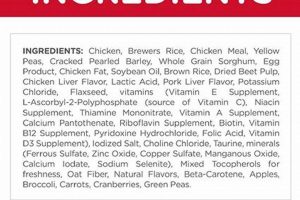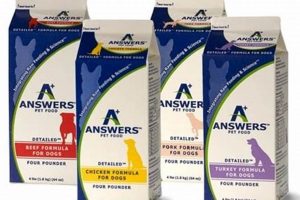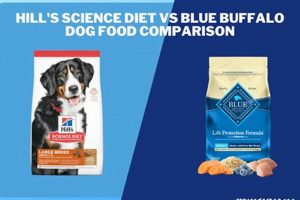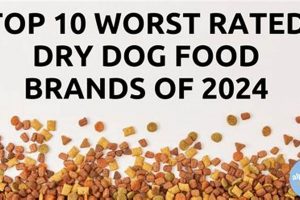The production method involves a slower cooking process at lower temperatures compared to extrusion, a common alternative. This technique typically preserves more nutrients and flavors from the original ingredients. An example would be a canine diet prepared with chicken, vegetables, and grains, gently cooked in a controlled heat environment to maintain its nutritional value.
A key advantage lies in the potential retention of vitamins, minerals, and amino acids that might be diminished during high-heat, high-pressure extrusion. This can lead to enhanced digestibility and palatability for the animal. The historical context reflects a growing interest in minimally processed pet foods, aligning with human trends towards natural and wholesome diets.
The following sections will delve into the specific nutritional aspects, ingredient selection criteria, and comparative analysis against other manufacturing methods for canine sustenance. These factors are critical for informed pet owner decisions regarding optimal dietary choices.
Oven Baked Dog Food
Selecting an appropriate diet for a canine companion requires careful consideration. The following tips provide essential guidance for pet owners interested in incorporating gently processed food into their dog’s nutritional regimen.
Tip 1: Prioritize Ingredient Quality. Scrutinize the ingredient list, ensuring that identifiable whole foods, such as named meats and vegetables, are listed prominently. Avoid products with excessive fillers or artificial additives.
Tip 2: Analyze Nutritional Adequacy. Verify that the food meets the Association of American Feed Control Officials (AAFCO) nutrient profiles for the dog’s life stage (growth, maintenance, or all life stages). Adequate protein, fat, and fiber content are crucial.
Tip 3: Observe Digestive Response. Introduce the new food gradually to minimize digestive upset. Monitor stool quality and consistency as indicators of digestive tolerance. Diarrhea or vomiting may indicate an intolerance.
Tip 4: Assess Palatability. While nutritional value is paramount, palatability influences consumption. Observe the dog’s willingness to eat the food. Decreased appetite may necessitate exploring alternative flavors or formulations.
Tip 5: Consider Specific Dietary Needs. Account for any underlying health conditions or sensitivities. Consult with a veterinarian to determine if a limited-ingredient diet or specialized formula is necessary.
Tip 6: Evaluate the Baking Process. Research the manufacturer’s baking process. Ensure that the food is cooked at appropriate temperatures and for sufficient durations to eliminate harmful bacteria while preserving nutrients.
Tip 7: Monitor for Allergic Reactions. Be vigilant for signs of food allergies, such as itching, skin irritation, or gastrointestinal distress. Eliminate suspected allergens from the diet and consult a veterinarian for allergy testing if needed.
By adhering to these guidelines, pet owners can make informed decisions about integrating gently processed food into their dog’s diet, promoting optimal health and well-being.
The subsequent sections will examine the comparative advantages and disadvantages of gently processed canine diets in relation to other commercially available options, further empowering pet owners to choose the best nutritional path for their dogs.
1. Nutrient Preservation
Nutrient preservation is a critical consideration in canine nutrition, particularly when evaluating different food processing methods. Gently processed formulas aim to minimize nutrient degradation, thereby maximizing the nutritional value of the diet.
- Vitamin Retention
The baking process, typically conducted at lower temperatures compared to extrusion, contributes to greater vitamin retention. Heat-sensitive vitamins, such as Vitamin A, Vitamin C, and certain B vitamins, are prone to degradation during high-temperature processing. Baking minimizes this loss, ensuring a more complete vitamin profile in the final product. For example, studies comparing vitamin content in extruded versus baked pet food have shown that baked foods retain a significantly higher percentage of these crucial nutrients.
- Amino Acid Integrity
Amino acids, the building blocks of protein, can be altered or damaged by excessive heat. The baking method helps preserve amino acid integrity, ensuring that the protein source remains bioavailable and effectively utilized by the animal. Maintaining the structure of amino acids is essential for muscle development, tissue repair, and overall metabolic function. Research suggests that the baking process prevents the formation of Maillard reaction products, which can reduce protein digestibility.
- Enzyme Activity
Some ingredients naturally contain beneficial enzymes that aid in digestion. High-heat processing can denature these enzymes, rendering them inactive. The baking process, with its lower temperatures, allows for the partial preservation of these enzymes. This can contribute to improved digestion and nutrient absorption. For instance, certain vegetable and grain components contain enzymes that assist in the breakdown of carbohydrates and proteins.
- Fatty Acid Stability
Unsaturated fatty acids, such as omega-3 and omega-6 fatty acids, are susceptible to oxidation and degradation when exposed to high heat and pressure. The gentle baking process helps maintain the stability of these essential fatty acids, preserving their beneficial properties for skin health, cognitive function, and inflammation control. For example, fish oils, a common source of omega-3 fatty acids, are particularly vulnerable to oxidation, making the baking process a more favorable method for preserving their nutritional value.
The preservation of nutrients through gentle baking represents a distinct advantage in canine nutrition. By minimizing the degradation of vitamins, amino acids, enzymes, and fatty acids, these diets offer a more complete and bioavailable source of essential nutrients, supporting optimal canine health and well-being. Further research comparing the long-term health outcomes of dogs fed gently processed versus extruded diets is warranted to fully quantify these benefits.
2. Digestibility Enhancement
The production method directly impacts the structural integrity of ingredients, influencing how efficiently a canine digestive system can process and absorb nutrients. The baking process, characterized by lower temperatures and longer cooking times compared to extrusion, promotes a more gentle breakdown of complex carbohydrates and proteins. This pre-emptive breakdown minimizes the workload on the dog’s digestive tract, facilitating easier enzyme access and more complete nutrient extraction. For instance, starch granules within grains become more readily digestible after baking, reducing the likelihood of undigested starch fermenting in the colon, a common cause of gastrointestinal distress.
Furthermore, the intact structure of protein molecules benefits from gentle heat application. High-pressure extrusion can denature proteins, rendering them less susceptible to enzymatic breakdown. The sustained, lower heat environment of baking allows proteins to unfold gradually, exposing more peptide bonds for digestive enzymes to cleave. This translates to improved amino acid availability, crucial for muscle maintenance and repair. A tangible example involves canines with sensitive stomachs; transitioning to diets prepared with this baking method often results in improved stool quality and reduced instances of vomiting or diarrhea, indicative of enhanced digestibility.
In summation, the connection between digestibility enhancement and the food preparation technique underscores a critical aspect of canine nutrition. The avoidance of extreme processing conditions supports the integrity of ingredient structures, facilitating more efficient digestion and nutrient absorption. While individual dietary needs vary, the digestibility benefits associated with this oven-based method present a compelling argument for its inclusion in canine diets, particularly for animals with compromised digestive function or sensitivities. Challenges remain in standardizing baking processes across manufacturers to ensure consistent digestibility profiles. Future research should focus on quantifying the specific impact of baking parameters on canine digestive health.
3. Palatability Improvement
Palatability, defined as the degree to which a food is appealing and readily consumed, represents a crucial determinant of nutritional intake in canines. The production method, specifically baking, can exert a significant influence on the sensory attributes of the food, ultimately impacting its acceptance by dogs.
- Enhanced Aroma Development
The baking process promotes the Maillard reaction, a chemical reaction between amino acids and reducing sugars that yields a complex array of volatile aroma compounds. These compounds contribute to a more appealing scent profile compared to extruded foods, which are often subjected to high heat and rapid processing, limiting the development of such aromatic complexities. For instance, the distinct, savory aroma emanating from baked meats often stimulates canine appetite more effectively than the blander scent of extruded kibble.
- Improved Texture Characteristics
The baking technique results in a drier, more porous texture that can be more appealing to some dogs. The increased surface area enhances the release of flavor compounds during chewing, providing a more satisfying sensory experience. Contrastingly, extruded foods often possess a denser, harder texture, which may be less palatable, particularly for smaller breeds or those with dental issues. An example is the preference observed in certain canines for the crumbly texture of baked treats over the harder consistency of standard kibble.
- Preservation of Natural Flavors
The lower temperatures used in baking can help preserve the natural flavors of the ingredients, preventing the volatilization or degradation of delicate flavor compounds. This contrasts with extrusion, where high heat can strip away natural flavors, necessitating the addition of artificial flavor enhancers to improve palatability. For example, the inherent sweetness of carrots or the savory notes of chicken are more likely to be retained in baked formulations, contributing to a more naturally appealing flavor profile.
- Minimization of Artificial Additives
Due to the enhanced aroma, texture, and flavor profiles achieved through the baking process, the need for artificial flavor enhancers, colors, and preservatives is often reduced. This appeals to pet owners seeking minimally processed food options. Artificial additives, while generally regarded as safe, can sometimes trigger adverse reactions in sensitive animals. Consequently, the reduced reliance on such additives in baked formulas can contribute to improved palatability by avoiding potential aversions or sensitivities.
The interplay between baking and palatability highlights the importance of considering sensory attributes in canine nutrition. By fostering enhanced aroma development, improving texture characteristics, preserving natural flavors, and minimizing artificial additives, the baking process can significantly enhance the appeal of dog food. Further, careful selection of ingredients known to be palatable to dogs, when combined with this processing method, can optimize the nutritional and sensory aspects of canine diets. Future research could examine the specific volatile compounds generated during baking and their impact on canine feeding behavior.
4. Ingredient Integrity
Ingredient integrity constitutes a foundational element in assessing the nutritional value and overall quality of canine diets, particularly in the context of oven baked formulations. The processing method employed directly impacts the preservation of original ingredient characteristics, influencing the bioavailability of nutrients and the overall health benefits derived from the food.
- Sourcing and Traceability
The origin and handling of ingredients prior to baking are critical. Reputable manufacturers prioritize traceable supply chains, ensuring that ingredients are sourced from reliable suppliers who adhere to stringent quality control measures. For instance, using named meat sources (e.g., chicken, beef) from certified facilities ensures that the protein source is free from contaminants and meets specified quality standards. Opaque or vaguely described “meat by-products” often lack the same level of traceability and quality assurance.
- Minimization of Processing Aids
The baking method, compared to extrusion, often necessitates fewer processing aids, such as artificial preservatives or stabilizers. Extrusion, due to its high-temperature, high-pressure environment, often requires additives to maintain the structural integrity of the kibble and extend shelf life. A diet formulated with a focus on ingredient integrity will prioritize natural preservation methods, such as vitamin E or rosemary extract, and minimize the use of synthetic additives.
- Preservation of Whole Food Structure
The baking process, with its lower temperatures, helps preserve the structural integrity of whole food ingredients. This allows for the retention of fiber content in vegetables and fruits, contributing to healthy digestion and gut microbiome support. For example, identifiable pieces of carrots or blueberries in a baked formula indicate a greater degree of whole food preservation compared to finely ground powders commonly found in extruded products.
- Nutrient Bioavailability
Ingredient integrity directly impacts nutrient bioavailability, the extent to which nutrients can be absorbed and utilized by the dog’s body. Over-processing can damage or alter the structure of nutrients, reducing their bioavailability. The baking method, by minimizing nutrient degradation, helps ensure that vitamins, minerals, and amino acids remain in a form that is easily absorbed and utilized. For instance, gently baked sweet potatoes retain a higher percentage of their vitamin A content compared to those subjected to high-heat processing.
In conclusion, the concept of ingredient integrity is intrinsically linked to oven baked canine diets. By emphasizing sourcing and traceability, minimizing processing aids, preserving whole food structure, and maximizing nutrient bioavailability, these formulations strive to deliver a more natural and nutritionally complete diet. While the baking process itself contributes to ingredient integrity, the selection of high-quality, minimally processed ingredients remains paramount. Further research is needed to fully quantify the long-term health benefits associated with diets formulated with a focus on ingredient integrity.
5. Processing Temperature
Processing temperature is a critical parameter in the manufacturing of canine diets, influencing nutrient retention, palatability, and overall food safety. In the context of oven baked dog food, temperature control becomes especially pertinent due to its impact on the integrity of ingredients and the preservation of heat-sensitive nutrients.
- Nutrient Degradation
Elevated processing temperatures can lead to the degradation of essential vitamins, minerals, and amino acids. Oven baking, typically employing lower temperatures compared to extrusion, minimizes this nutrient loss. For example, Vitamin C, a heat-sensitive nutrient, is more effectively retained in baked formulations where temperatures are carefully regulated to remain below its degradation point. The implication is a nutritionally superior product with enhanced bioavailability of key micronutrients.
- Maillard Reaction and Palatability
The Maillard reaction, a chemical reaction between amino acids and reducing sugars, is highly temperature-dependent. Controlled baking temperatures allow for the development of desirable flavor and aroma compounds without excessive browning or the formation of harmful advanced glycation end products (AGEs). Overbaking, even at moderately high temperatures, can result in burnt flavors and reduced palatability. Thus, precise temperature control ensures an appealing taste profile that encourages consumption.
- Pathogen Control
While lower temperatures are beneficial for nutrient preservation, ensuring adequate pathogen control is paramount. The baking process must reach a sufficient internal temperature to eliminate harmful bacteria, such as Salmonella and E. coli. Time-temperature combinations are carefully calibrated to achieve both food safety and nutrient retention. For example, adhering to USDA guidelines for minimum internal cooking temperatures is essential to mitigate the risk of foodborne illness in pets.
- Ingredient Structure and Digestibility
Processing temperature affects the structural integrity of ingredients, influencing digestibility. Excessive heat can denature proteins and gelatinize starches, potentially reducing their bioavailability. Oven baking, when properly controlled, maintains a more natural structure of ingredients, facilitating easier enzymatic breakdown in the canine digestive system. This results in improved nutrient absorption and reduced risk of gastrointestinal upset. For instance, gently baked starches are more readily digestible than those subjected to high-heat extrusion.
The interplay between processing temperature and the resultant quality of oven baked dog food underscores the importance of precise manufacturing practices. Optimizing baking parameters to balance nutrient preservation, palatability, pathogen control, and digestibility is crucial for producing a safe and nutritionally superior canine diet. Further investigation into the long-term health effects of temperature-controlled baking methods compared to alternative processing techniques is warranted to fully elucidate the benefits of this approach.
Frequently Asked Questions
This section addresses common inquiries regarding diets manufactured using the oven baking method, providing clarity on their nutritional value, safety, and suitability for various canine populations.
Question 1: Is oven baked dog food nutritionally complete?
Diets must meet the Association of American Feed Control Officials (AAFCO) nutrient profiles for the specified life stage (growth, maintenance, all life stages) to be considered nutritionally complete. Always verify the AAFCO statement on the packaging to ensure adequacy.
Question 2: Is oven baked dog food safe for canines?
The baking process, when conducted according to established food safety protocols, effectively eliminates harmful bacteria such as Salmonella and E. coli. Reputable manufacturers adhere to strict quality control measures to ensure product safety. Examine recall history and certifications before selecting a product.
Question 3: Does oven baking preserve more nutrients than extrusion?
Lower processing temperatures typically associated with baking can help retain heat-sensitive vitamins, minerals, and amino acids that may be degraded during high-temperature extrusion. However, the specific nutrient content is also influenced by ingredient quality and formulation.
Question 4: Is oven baked dog food more expensive than extruded kibble?
Often, oven baked diets are priced higher than conventional extruded kibble due to factors such as specialized manufacturing processes and potentially higher quality ingredients. Price comparisons should consider the cost per serving and the nutritional density of the food.
Question 5: Is oven baked dog food suitable for all breeds and life stages?
The suitability of any diet depends on the individual dog’s needs. Formulations exist for various life stages (puppy, adult, senior) and specific health conditions. Consulting a veterinarian is recommended to determine the most appropriate diet for a particular canine.
Question 6: How should oven baked dog food be stored?
Proper storage is essential to maintain freshness and prevent spoilage. Diets should be stored in a cool, dry place, in an airtight container. Follow manufacturer recommendations regarding shelf life and storage conditions.
In summary, diets offer potential advantages in terms of nutrient preservation and digestibility, but careful consideration of ingredient quality, AAFCO statements, and individual canine needs is crucial. Consulting with a veterinarian is always recommended for personalized dietary guidance.
The following section will provide a comparative analysis between oven baked diets and other commercially available canine food options.
Conclusion
This exploration has demonstrated that the processing method, specifically baking, offers distinct advantages in canine nutrition. Key among these are enhanced nutrient preservation, improved digestibility, and potentially greater palatability. The selection of high-quality ingredients and adherence to AAFCO guidelines remain paramount regardless of the chosen manufacturing process. Properly formulated oven baked dog food can serve as a viable option for pet owners seeking a minimally processed, nutritionally complete diet for their canine companions.
Continued research is vital to fully understand the long-term health implications of various processing methods on canine health. Pet owners are encouraged to critically evaluate all available dietary options, consult with veterinary professionals, and prioritize the individual needs of their dogs when making nutritional decisions. The future of canine nutrition will likely see a continued focus on minimally processed, whole food-based diets, and informed consumer choices will drive further innovation in this area.


![Best Gravy for Dogs Dry Food? + [Tips & Guide] World’s Most Delicious Foods: Must-Try Dishes from Every Country Best Gravy for Dogs Dry Food? + [Tips & Guide] | World’s Most Delicious Foods: Must-Try Dishes from Every Country](https://lisasfoods.com/wp-content/uploads/2025/12/th-772-300x200.jpg)




